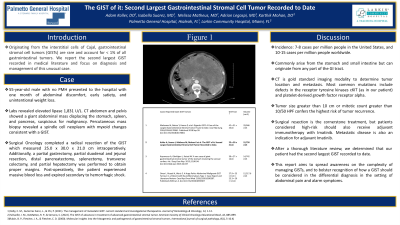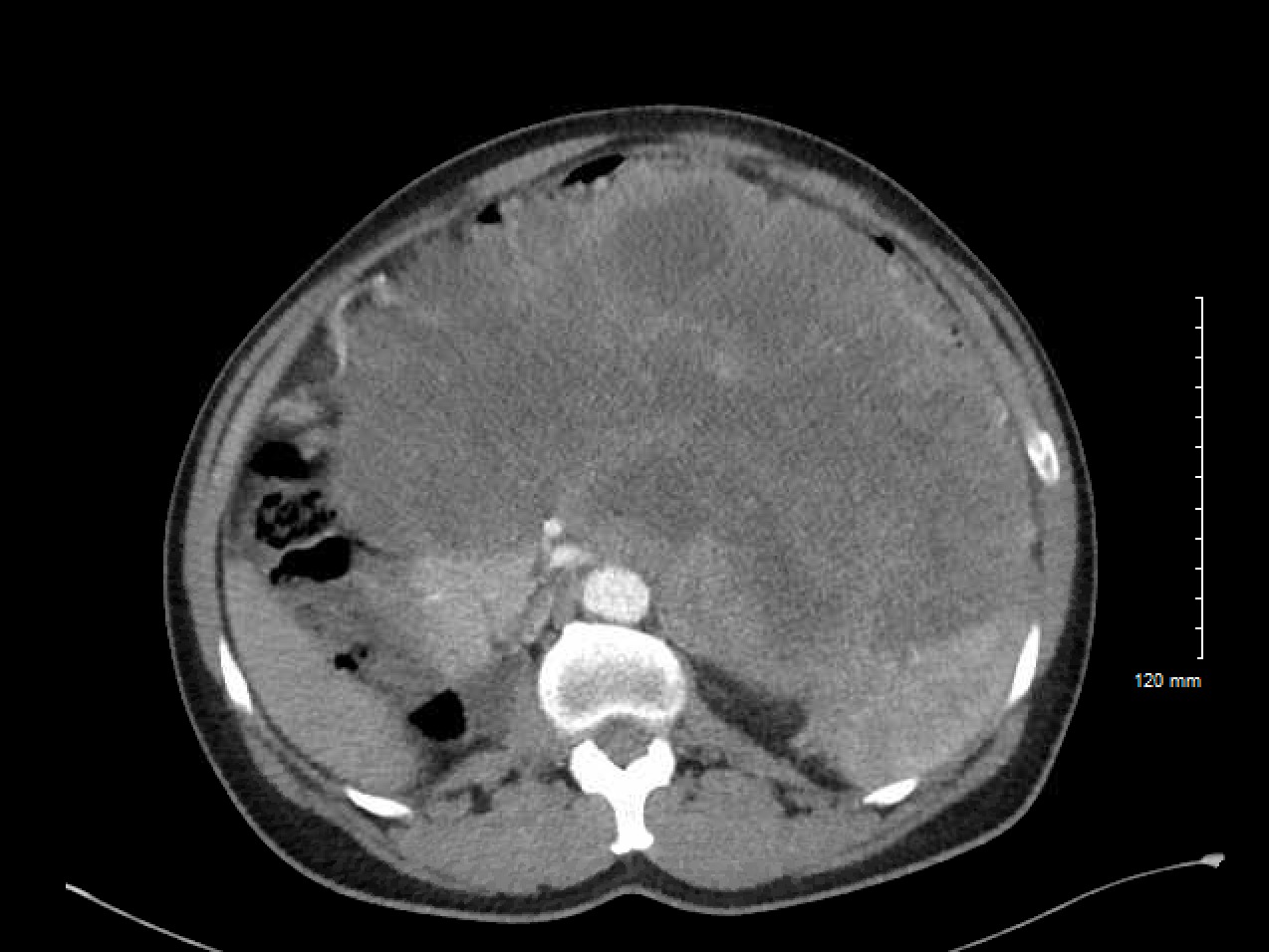Tuesday Poster Session
Category: Stomach
P4213 - The GIST of It: Second Largest Gastrointestinal Stromal Cell Tumor Recorded to Date
Tuesday, October 24, 2023
10:30 AM - 4:00 PM PT
Location: Exhibit Hall

Has Audio

Adam Z. Koller, DO, MS
Palmetto General Hospital
Coral Gables, FL
Presenting Author(s)
Adam Z. Koller, DO, MS1, Isabella Suarez Alcala, MD2, Melissa Matheus, MD3, Sarah Arvaneh, DO4, Adrian Legaspi, MD2, Luis Nasiff, MD4
1Palmetto General Hospital, Coral Gables, FL; 2Palmetto General Hospital, Hialeah, FL; 3Larkin Community Hospital, Palm Springs Campus, Doral, FL; 4Larkin Community Hospital, Hialeah, FL
Introduction: Originating from the interstitial cells of Cajal, gastrointestinal stromal cell tumors (GISTs) are rare and account for less than 1% of all gastrointestinal tumors. We report the second largest GIST recorded in medical literature and focus on diagnosis and management of this unusual case.
Case Description/Methods: A 55-year-old male with no medical history presented to the hospital with one month of abdominal discomfort, early satiety, and unintentional weight loss. On admission, patient was hemodynamically stable. Physical examination revealed a diffusely distended and tender abdomen. Labs revealed an elevated lipase of 1,831 U/L. Computed tomography (CT) abdomen and pelvis showed a giant abdominal mass displacing the stomach, spleen, and pancreas, suspicious for malignancy. Percutaneous mass biopsy revealed a spindle cell neoplasm with myxoid changes consistent with a GIST. Surgical Oncology completed a radical resection of the GIST which measured 25.0 x 30.0 x 21.0 cm intraoperatively. Additionally, a partial gastrectomy, partial duodenal and jejunal resection, distal pancreatectomy, splenectomy, transverse colectomy, and partial hepatectomy was performed to obtain proper margins. Post-operatively, the patient experienced massive blood loss and expired secondary to hemorrhagic shock.
Discussion: GISTs have an incidence of 7-8 cases per million people in the United States, and 10-15 cases per million people worldwide. They commonly arise from the stomach and small intestine but can originate from any part of the GI tract. CT is the gold standard imaging modality to determine tumor location and metastasis. The most common mutations include defects in the receptor tyrosine kinases cKIT (as in our patient) and platelet-derived growth factor receptor alpha. While multiple prognostic classification systems exist, it is widely recognized that tumor size greater than 10 cm or mitotic count greater than 10/50 HPF confer the highest risk of tumor recurrence. Surgical resection is the cornerstone treatment, but patients considered high-risk should also receive adjuvant immunotherapy with Imatinib. Metastatic disease is also an indication for adjuvant Imatinib. Interestingly, after a thorough literature review, we determined that our patient had the second largest GIST recorded to date. This report aims to spread awareness on the complexity of managing GISTs, and to bolster recognition of how a GIST should be considered in the differential diagnosis in the setting of abdominal pain and alarm symptoms.

Disclosures:
Adam Z. Koller, DO, MS1, Isabella Suarez Alcala, MD2, Melissa Matheus, MD3, Sarah Arvaneh, DO4, Adrian Legaspi, MD2, Luis Nasiff, MD4. P4213 - The GIST of It: Second Largest Gastrointestinal Stromal Cell Tumor Recorded to Date, ACG 2023 Annual Scientific Meeting Abstracts. Vancouver, BC, Canada: American College of Gastroenterology.
1Palmetto General Hospital, Coral Gables, FL; 2Palmetto General Hospital, Hialeah, FL; 3Larkin Community Hospital, Palm Springs Campus, Doral, FL; 4Larkin Community Hospital, Hialeah, FL
Introduction: Originating from the interstitial cells of Cajal, gastrointestinal stromal cell tumors (GISTs) are rare and account for less than 1% of all gastrointestinal tumors. We report the second largest GIST recorded in medical literature and focus on diagnosis and management of this unusual case.
Case Description/Methods: A 55-year-old male with no medical history presented to the hospital with one month of abdominal discomfort, early satiety, and unintentional weight loss. On admission, patient was hemodynamically stable. Physical examination revealed a diffusely distended and tender abdomen. Labs revealed an elevated lipase of 1,831 U/L. Computed tomography (CT) abdomen and pelvis showed a giant abdominal mass displacing the stomach, spleen, and pancreas, suspicious for malignancy. Percutaneous mass biopsy revealed a spindle cell neoplasm with myxoid changes consistent with a GIST. Surgical Oncology completed a radical resection of the GIST which measured 25.0 x 30.0 x 21.0 cm intraoperatively. Additionally, a partial gastrectomy, partial duodenal and jejunal resection, distal pancreatectomy, splenectomy, transverse colectomy, and partial hepatectomy was performed to obtain proper margins. Post-operatively, the patient experienced massive blood loss and expired secondary to hemorrhagic shock.
Discussion: GISTs have an incidence of 7-8 cases per million people in the United States, and 10-15 cases per million people worldwide. They commonly arise from the stomach and small intestine but can originate from any part of the GI tract. CT is the gold standard imaging modality to determine tumor location and metastasis. The most common mutations include defects in the receptor tyrosine kinases cKIT (as in our patient) and platelet-derived growth factor receptor alpha. While multiple prognostic classification systems exist, it is widely recognized that tumor size greater than 10 cm or mitotic count greater than 10/50 HPF confer the highest risk of tumor recurrence. Surgical resection is the cornerstone treatment, but patients considered high-risk should also receive adjuvant immunotherapy with Imatinib. Metastatic disease is also an indication for adjuvant Imatinib. Interestingly, after a thorough literature review, we determined that our patient had the second largest GIST recorded to date. This report aims to spread awareness on the complexity of managing GISTs, and to bolster recognition of how a GIST should be considered in the differential diagnosis in the setting of abdominal pain and alarm symptoms.

Figure: Computed Tomography Scan with IV Contrast Revealing Massive Intra-abdominal GIST
Disclosures:
Adam Koller indicated no relevant financial relationships.
Isabella Suarez Alcala indicated no relevant financial relationships.
Melissa Matheus indicated no relevant financial relationships.
Sarah Arvaneh indicated no relevant financial relationships.
Adrian Legaspi indicated no relevant financial relationships.
Luis Nasiff indicated no relevant financial relationships.
Adam Z. Koller, DO, MS1, Isabella Suarez Alcala, MD2, Melissa Matheus, MD3, Sarah Arvaneh, DO4, Adrian Legaspi, MD2, Luis Nasiff, MD4. P4213 - The GIST of It: Second Largest Gastrointestinal Stromal Cell Tumor Recorded to Date, ACG 2023 Annual Scientific Meeting Abstracts. Vancouver, BC, Canada: American College of Gastroenterology.
